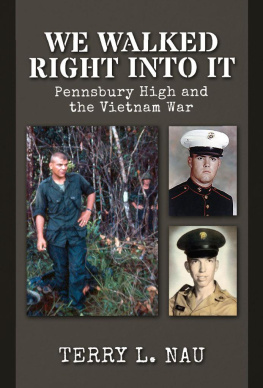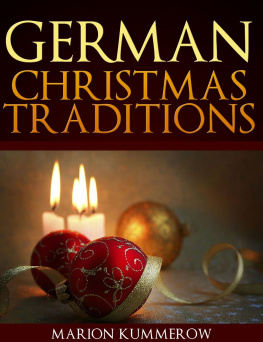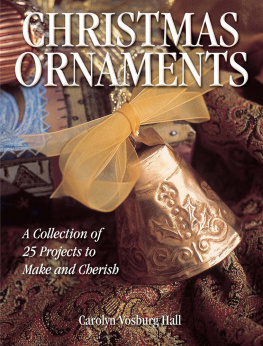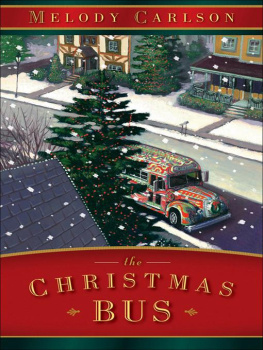
On the cover: Lt. Joseph Paul Yatsko Jr., left photo; Marine PFC Michael Brian McGinnis, top right; Army PFC James Walker (Rick) Guest, bottom right.
Copyright 2015 Terry L. Nau
All rights reserved.
ISBN 13: 978-1505881134
ISBN 10:1505881137
(This book is dedicated to the 15 former Pennsbury students who died in Vietnam and to all of the schools alumni who have served in the United States Armed Forces, especially my brothers, Dan and Tim Nau, and my cousin, Ronald Nau.)
TABLE OF CONTENTS
PROLOGUE:
SUBURBS RISE OUT OF FARMLAND
A s WORLD WAR II ENDED, lush green farmland dominated the region northeast of Philadelphia, in a place known as Lower Bucks County. Villages that existed during the Revolutionary War near the Delaware River, sparse settlements that eventually became Yardley, Morrisville, Bristol and Fallsington, would develop their own identities and history over the ensuing 175 years. George Washington really did sleep here, along with his troops, and it was from a point just north of Yardley Village that he and his soldiers crossed the river and attacked the Hessians in the Battle of Trenton on Dec. 26, 1776.
With American soldiers coming home from World War II, the serene landscape of Lower Bucks would begin to change. In 1950, United States Steel President Ben Fairless approved construction of a 2,500-acre mill along the Delaware River that would bring an estimated 10,000 jobs to the region. Fairless needed to build a community of suburban homes to house steelworkers who flocked to his new project. He authorized a subsidiary company of USS to slap together 3,220 pre-fabricated homes along the old Route 1 highway. This modest company town named Fairless Hills would be completed within five years. The first transplanted steelworkers arrived in 1952 just in time for the opening of the Fairless Works steel plant.
sBy 1958, this new Levittown would consist of 17,311 homes suited for raising young families in safe neighborhoods. The population quickly reached 70,000 people over the first decade. Levitt set aside land for schools, playgrounds and one shopping center, developing a self-contained mode of living that earned him the title creator of the modern suburb.
Many farm owners sold most or all of their land to real-estate developers. The burgeoning suburbs imposed their new style of living on the old farmland. Two drive-in movie theaters popped up along Route 1, displacing the cows and apple orchards and corn fields with huge movie screens and vast parking lots. Strip malls and fast-food restaurants materialized along roads throughout Lower Bucks County. In 1956, a new hamburger chain called McDonalds opened a store on Route 13 in Bristol Township, drawing customers from nearby towns. Other burgeoning fast food chains, with names like Ginos and Steer Inn, would follow McDonalds lead.
With the new homes and families came young children born after World War II, the heralded Baby Boomer generation that would come of age in the mid-1960s. Parents, products of the Great Depression three decades earlier, set high standards for their offspring. College became a reasonable option, even for the children of blue-collar steel workers.
New school structures sprung up out of the ground in Levittown and Fairless Hills right along with the houses. The Pennsbury school system would expand constantly over the next 20 years, transforming from a quaint high school facility located in Yardley to a huge campus on the Fairless Hills/Levittown border in 1966 as the Baby Boomer generation hit full stride. Pennsbury graduated 725 seniors in 1965. The number would rise to more than 1,200 by the early 1970s before leveling off.
Families newly settled in Lower Bucks County were stepping up into the middle class when they purchased their suburban homes. In 1953, Joseph and Helen Yatsko and their three sons left the coal mining town of Mount Carmel to take up residence in the North Park section of Levittown. All three of the sons would join the Army and two would end up fighting to suppress communism in Vietnam by 1965.
Levittown was a great place to grow up, youngest son Mike Yatsko remembered many years later. We had our own bathroom inside the house, along with hot water. That was a big upgrade from our house in Mount Carmel, where we were still using an outhouse and had only cold running water.
In retrospect, it seemed like the 1980s television series The Wonder Years had taken its inspiration from Levittown and Fairless Hills, these new suburban communities that squeezed homes within 15 feet of one another, creating an immediate bond among neighbors who had no choice but to get along. Arguments in one house could be heard two houses away. If a pre-fab Fairless Hills house went up in flames, the structure would burn to the foundation within 20 minutes. Fortunately, house fires were rare in those days, possibly because everyone knew the consequences.
By the late 1950s, Pennsbury High students started making their own reputations on the sports fields, competing against powerful Neshaminy High from nearby Langhorne, a school system that also exploded in size after slicing its chunk of students out of the Levittown pie. Pennsbury developed athletes like Vernon Von Sydow, a Class of 1958 football star who would enter the Naval Academy and later serve three tours of duty as a helicopter pilot, rescuing downed jet fighter pilots in the ocean waters bordering Vietnam.
The world opened up to these offspring of the Greatest Generation. College was now a reasonable expectation for anyone with solid grades and a decent score on the entrance exams. The Cold War cast a huge shadow over everyones lives as Fidel Castro won his Communist revolution in Cuba, and Soviet Union premier Nikita Khrushchev pounded a shoe on his table at the United Nations. The future appeared both troubling and full of hope, even if nuclear warfare sometimes seemed just around the corner.
Rising young politician John Fitzgerald Kennedy narrowly captured the American presidential election on Nov. 8, 1960. He spoke of a New Frontier at the Levittown Shopping Center during the weekend before his triumph, playing directly to union workers who formed the core of his constituency in the late 1950s. In his inaugural address two months later, Kennedy would famously assert, Ask not what your country can do for you. Ask what you can do for your country.

GREETINGS Pennsbury High graduate Vern Von Sydow, second from left, stood in line during the summer of 1962 to meet President John Kennedy in Newport, R.I., where the Naval Academy football team was holding its preseason camp. At Kennedys side is Navy coach Wayne Hardin.
Kennedy ushered in a new era of optimism. He got people thinking when he said, The torch has been passed to a new generation of Americans born in this century, tempered by war, disciplined by a hard and bitter peace.
The former Senator from Massachusetts, just 43 years old when he took office, came from the same generation as the parents who were raising families in Lower Bucks County. Kennedy had a beautiful wife, Jacqueline, and two children, Caroline and John Jr. Having a young family in the White House seemed to revitalize The Greatest Generation, which now had one of its own calling the shots. Baby Boomers were growing up with the Kennedys, too, seeing this attractive family as a form of American royalty.
As the 1960s advanced, two and three automobiles began to fill the driveways of homes all over Lower Bucks County. Americas middle class welcomed these steelworkers and their families, putting them alongside the sons and daughters of white-collar workers, planting the same dreams in each. Pennsbury High blended the sons and daughters of steel workers with the children of white-collar executives from Yardley and nearby Lower Makefield. The world seemed like a fair place, filled with opportunities for children of these nearly all-white suburban communities.
Next page













